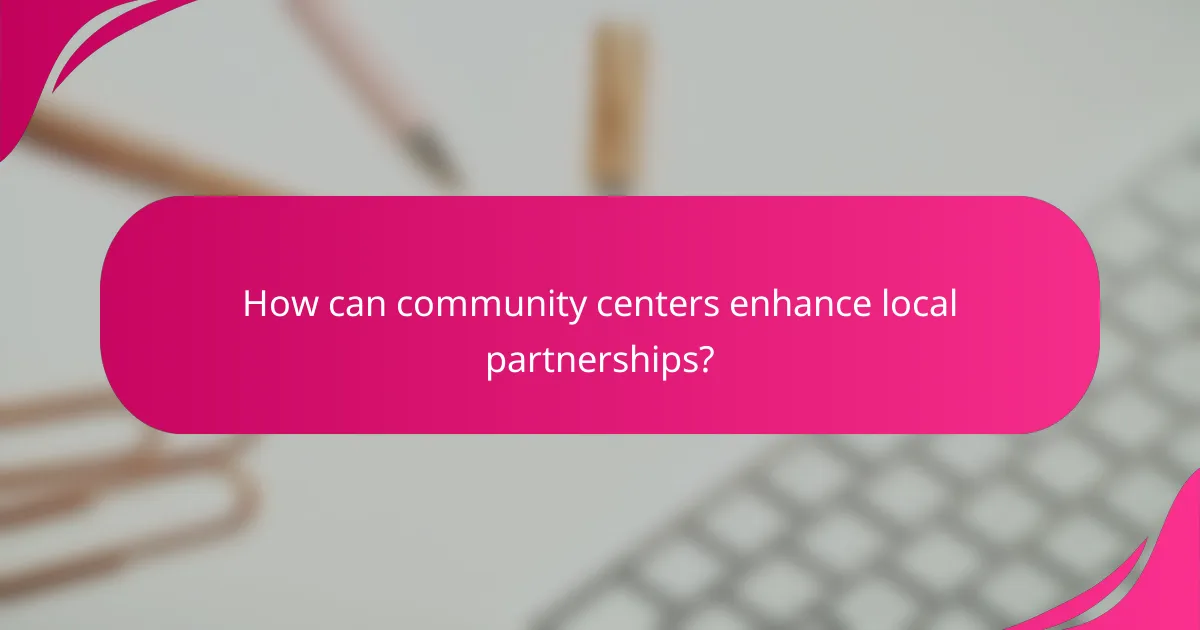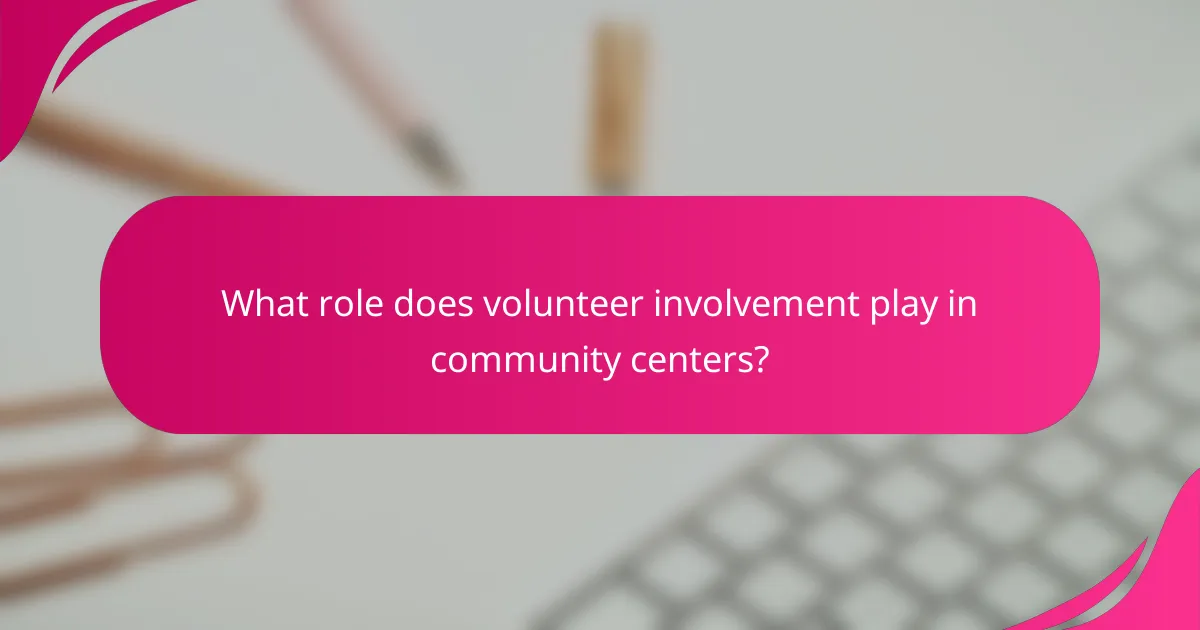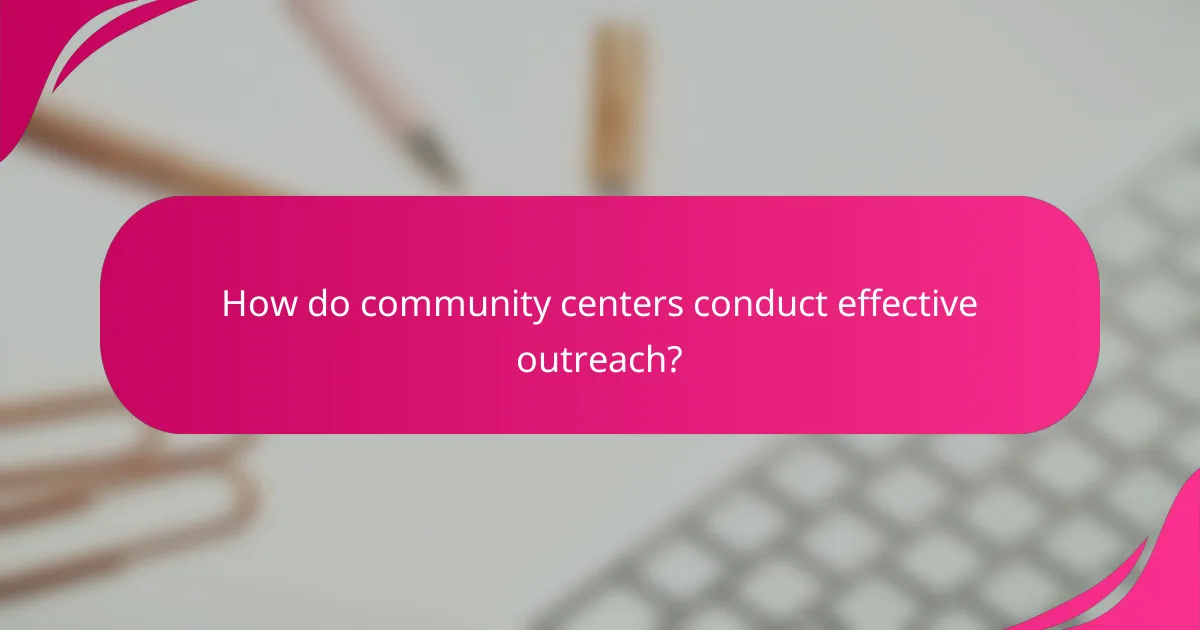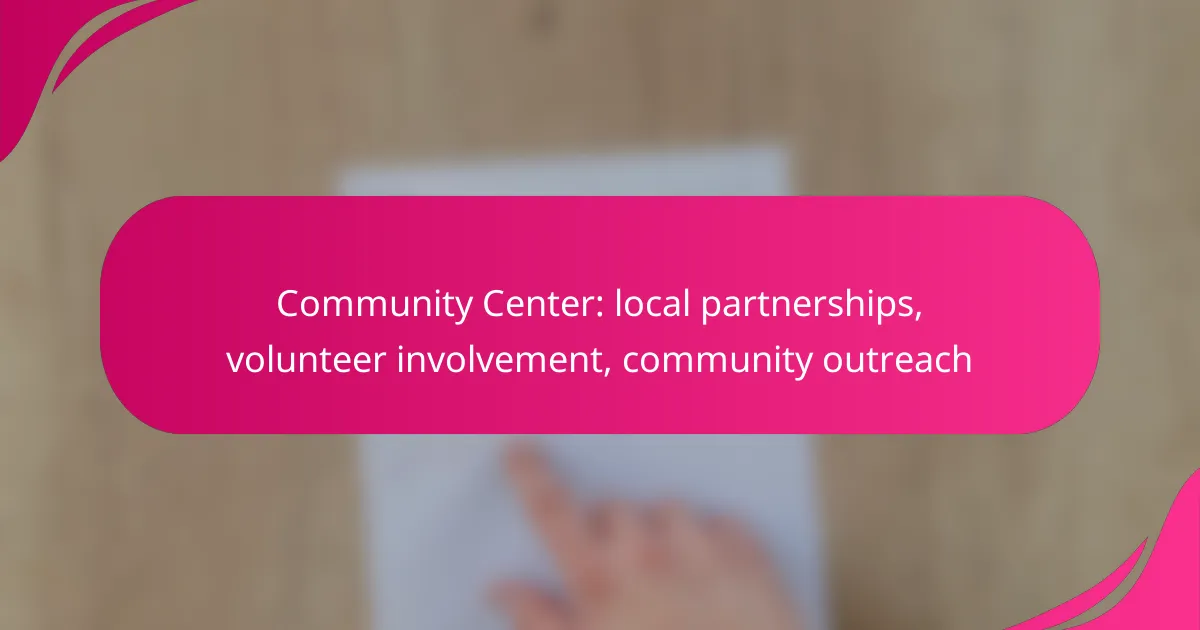Community centers play a vital role in strengthening local partnerships by uniting businesses, educational institutions, and non-profits to create a supportive network. Through active volunteer involvement, these centers enhance service delivery and foster community engagement, ensuring that diverse skills and perspectives are utilized. Additionally, effective outreach strategies help connect with residents and organizations, raising awareness of available services and encouraging participation in community activities.

How can community centers enhance local partnerships?
Community centers can enhance local partnerships by fostering collaboration among various stakeholders, including businesses, educational institutions, and non-profits. These partnerships create a network of support that benefits the entire community through shared resources and initiatives.
Collaboration with local businesses
Community centers can collaborate with local businesses to create mutually beneficial programs. For instance, businesses can sponsor events or provide discounts for community center members, while the center promotes these businesses through its networks.
Establishing clear communication channels and setting shared goals can strengthen these partnerships. Regular meetings and feedback sessions help ensure that both parties are aligned and can adapt to changing community needs.
Engagement with schools and universities
Engaging with schools and universities allows community centers to tap into educational resources and volunteer support. Programs such as after-school tutoring or workshops can be developed, benefiting students while providing valuable experience for university volunteers.
Creating internship opportunities for students at the community center can also enhance engagement. This not only supports students’ career development but also brings fresh ideas and energy to the center’s initiatives.
Partnerships with non-profit organizations
Forming partnerships with non-profit organizations can amplify the impact of community centers. Non-profits often have expertise in specific areas, such as health, education, or social services, which can complement the center’s offerings.
Joint initiatives, such as health fairs or educational workshops, can attract a wider audience and provide essential services to the community. Establishing clear roles and responsibilities is crucial for the success of these partnerships.
Joint events with local government
Community centers can host joint events with local government to promote civic engagement and community development. These events can include town hall meetings, public forums, or cultural celebrations that encourage community participation.
Working closely with local officials ensures that the events address community concerns and priorities. It also helps to build trust and transparency between the government and residents.
Networking with community leaders
Networking with community leaders is essential for community centers to stay informed about local issues and opportunities. Regular interactions with leaders from various sectors can lead to collaborative projects that address specific community needs.
Hosting networking events or informal gatherings can facilitate these connections. It’s important to create an inclusive environment where all voices are heard and valued, fostering a sense of community ownership and involvement.

What role does volunteer involvement play in community centers?
Volunteer involvement is crucial for community centers as it enhances service delivery and fosters community engagement. Volunteers bring diverse skills and perspectives, helping to create a vibrant environment that meets local needs.
Recruitment of local volunteers
Recruiting local volunteers involves identifying community members who are passionate about contributing to local initiatives. Effective strategies include hosting informational sessions, utilizing social media platforms, and collaborating with local organizations to reach potential volunteers.
Community centers can also create targeted outreach programs that appeal to specific demographics, such as students or retirees, to ensure a diverse volunteer base. Engaging with schools and universities can yield enthusiastic volunteers eager to gain experience.
Training programs for volunteers
Training programs for volunteers are essential to equip them with the necessary skills and knowledge to perform their roles effectively. These programs should cover the center’s mission, specific tasks, and any relevant safety protocols.
Offering flexible training schedules, including online modules and in-person workshops, can accommodate different availability. Regular refresher courses can also help maintain high standards and keep volunteers engaged.
Volunteer recognition initiatives
Recognizing volunteers is vital for maintaining motivation and encouraging continued involvement. Initiatives can include awards ceremonies, appreciation events, or simple thank-you notes that acknowledge their contributions.
Community centers may also implement a volunteer of the month program, showcasing individual efforts through newsletters or social media, which helps build a sense of community and belonging among volunteers.
Impact of volunteers on community programs
Volunteers significantly impact community programs by providing additional manpower and diverse skills, which can enhance the quality and reach of services offered. Their involvement often leads to increased participation in programs and events.
Moreover, volunteers can help identify community needs through their interactions, allowing centers to adapt and improve services. This feedback loop fosters a responsive environment that better serves the community’s evolving needs.

How do community centers conduct effective outreach?
Community centers conduct effective outreach by leveraging various communication strategies to engage with local residents and organizations. These methods help build relationships, raise awareness of services, and encourage participation in community activities.
Utilizing social media platforms
Social media platforms are essential tools for community centers to reach a wide audience quickly. By creating engaging content and regularly updating their profiles, centers can inform the community about upcoming events and initiatives.
Targeted advertising on platforms like Facebook and Instagram can also help attract specific demographics, ensuring that outreach efforts are effective and relevant. Regular interaction with followers through comments and messages fosters a sense of community and encourages more participation.
Hosting community events and workshops
Hosting events and workshops allows community centers to connect directly with residents. These gatherings provide opportunities for face-to-face interaction, enabling centers to showcase their services and gather feedback.
Events can range from family fun days to educational workshops, catering to diverse interests. Offering incentives, such as free refreshments or giveaways, can further enhance participation and create a welcoming atmosphere.
Creating informative newsletters
Informative newsletters are a practical way for community centers to keep residents updated on programs and events. These newsletters can be distributed via email or printed copies, ensuring accessibility for all community members.
Including success stories, upcoming activities, and volunteer opportunities can make newsletters more engaging. Regularly scheduled newsletters, such as monthly or quarterly, help establish consistency and keep the community informed.
Collaborating with local media
Collaborating with local media outlets can significantly enhance a community center’s outreach efforts. Press releases, interviews, and feature articles can help spread the word about important initiatives and events.
Building relationships with local journalists and media personalities can lead to ongoing coverage and support for community programs. This collaboration not only raises awareness but also legitimizes the center’s efforts in the eyes of the community.

What are the benefits of community center partnerships?
Community center partnerships provide numerous advantages, including resource sharing, funding opportunities, and enhanced outreach. These collaborations can significantly strengthen community programs and initiatives, leading to a more engaged and supportive environment.
Resource sharing among partners
Resource sharing is a fundamental benefit of community center partnerships. By collaborating, organizations can pool their resources, such as facilities, equipment, and expertise, which reduces costs and maximizes impact. For instance, a local school might partner with a community center to use its gymnasium for after-school sports programs.
Additionally, sharing volunteers and staff can enhance program delivery. For example, a health organization might provide trained personnel for wellness workshops at the community center, benefiting both parties and the community.
Increased program funding opportunities
Partnerships can open doors to increased funding opportunities. Many grant programs favor collaborative projects, as they demonstrate a unified approach to addressing community needs. By combining efforts, partners can apply for larger grants that may not be accessible to individual organizations.
Furthermore, local businesses may be more inclined to sponsor initiatives that involve multiple community entities, seeing it as a way to enhance their corporate social responsibility. This can lead to additional financial support for programs that serve the community.
Broader community impact
Community center partnerships can lead to a broader impact by addressing various community issues through a unified approach. When organizations work together, they can create comprehensive programs that tackle multiple aspects of community well-being, such as health, education, and social services.
For instance, a partnership between a food bank and a community center can provide not only food assistance but also nutrition education and cooking classes, thereby improving overall community health and knowledge.
Enhanced visibility and outreach
Collaborating with other organizations enhances visibility and outreach for all partners involved. Joint marketing efforts can reach a wider audience, increasing awareness of available services and programs. This can be particularly effective through shared social media campaigns or community events.
Moreover, partnerships can help build trust within the community. When residents see multiple organizations working together, they may feel more confident in participating in programs, knowing that these initiatives are backed by a coalition of trusted entities.

What criteria should be considered for selecting partners?
Selecting partners for a community center involves evaluating several key criteria to ensure alignment and effectiveness. Considerations should include mission alignment, community impact potential, and resource availability.
Alignment of mission and values
Ensuring that potential partners share similar missions and values is crucial for successful collaboration. This alignment fosters a unified approach to community goals and enhances the effectiveness of joint initiatives.
To assess alignment, review each partner’s mission statement and past projects. Look for common themes, such as community development, education, or health promotion. For example, a local health organization partnering with a community center focused on wellness can create impactful health programs.
When evaluating alignment, consider conducting meetings or workshops to discuss shared objectives and values. This can help identify any discrepancies early on and establish a foundation for a successful partnership.



